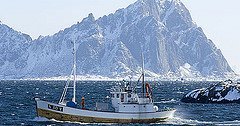Affected directly by climate change ensuing from activities often conducted far away by industrialized countries, indigenous peoples of the Arctic suffer a wide range of negative social, cultural and health consequences. This sad picture is of course true for indigenous communities worldwide. However, when we consider that many Arctic indigenous communities reside within the EU, one might question what impact this fact could or should have on the EU’s environmental policies in the global political discourse on climate change, for the benefit of EU’s Arctic indigenous, and for all.
Environmental degradation: Not only the polar bear
Indigenous peoples in the Arctic depend on hunting, reindeer herding, fishing and gathering – not only for food, but also as a basis for their cultural and social identity. Climate change is increasingly affecting this basis of subsistence and identity. Melting permafrost causing erosion results in the collapse of houses and other structures, and hunters fall through the sea-ice whilst travelling on areas that were traditionally regarded as safe. Environmental changes affect the indigenous Arctic animals, as do new invasive flora and fauna species inhabiting the region. The picture is generally that of unbalance and increasing degradation of the fragile ecosystem, posing severe challenges to the people dependant on it. As their way of life is threatened, an increase in poverty, alcoholism and other social problems has been noted. Indigenous people are generally characterised as being among the world’s most marginalized, impoverished and vulnerable.
There are examples of Arctic indigenous peoples being granted the right to exploit their own natural resources, such as oil off the coast of Greenland, which has recently been subject to settlement within a Working Group of the Danish-Greenlandic Home-rule Commission, directed of course by the present relations between Greenland – on the road to increased self-rule – and the State of Denmark. Such extraction possibilities could, if realised in a sustainable way, be of benefit to the economic development of the people, but could also result in conflicting interests within indigenous communities, who are caught between adapting to an industrialising and globalized world, and preserving the environment and their traditional way of life. It can be framed as a choice between being exploited, or demanding benefits from the exploitation.
What could be expected from a “solidaric” European Union?
Despite being among those most affected by climate change, indigenous peoples’ rights and concerns have so far been almost invisible in the climate change discussions
“Despite being among those most affected by climate change, indigenous peoples’ rights and concerns have so far been almost invisible in the climate change discussions at the national, regional and international level.”[[Conference on Indigenous Peoples and Climate Change, Copenhagen, 21 – 22 February 2008, MEETING REPORT submitted by the International Work Group for Indigenous Affairs (IWGIA) - http://www.un.org/esa/socdev/unpfii/] Unable to participate with a sufficiently strong voice in political processes vital to their very existence, the plight of indigenous people has become a question of socio-economic inequality, and undoubtedly a human rights issue – and this is no less true for the Arctic’s indigenous. They stand together in organisations such as the Saami Council and the Inuit Circumpolar Conference, and participate in the work of the Arctic Council. However, at the Arctic Council, only non-legally binding instruments are adopted, and the Arctic States are generally criticiseable for their lack of concrete commitments on Arctic environmental issues, being driven rather by their economic interests in the area, as the recent “oil rush” for the Arctic indicates. Furthermore, since many of the Arctic indigenous peoples’ environmental and human rights concerns stem from global activities and climate change, action is needed on a larger scale.
With its growing human rights profile, and with the support of the EU Member States for the adoption of the UN Declaration on the Rights of Indigenous Peoples by the UN General Assembly in 2007 (albeit non-binding, it is considered an important step in the development of indigenous people’s rights), one could perhaps expect more from the EU on the issue of indigenous people’s rights in the face of climate change, especially in the light of the problems faced by EU Arctic minorities. Although the EU Northern Dimension deals with environmental policies and protection of indigenous peoples in the North, in the outward global discourse on climate change, the concrete challenges and limitation of rights faced on a daily-life basis by (Arctic) indigenous peoples, as a direct result of climate change, unfortunately do not seem to be high on the EU’s – or anybody’s – agenda.
In order to further social justice, and to show respect for the rights of indigenous peoples to be secure in the enjoyment of their own means of subsistence and development (article 20 of the UN Declaration), and to the conservation and protection of the environment and the productive capacity of their lands or territories and resources (article 29 of the UN Declaration), it would be a welcome development, if the EU were to increase its external discourse regarding the direct effects of climate change on indigenous peoples, taking into account the concerns of its own indigenous population in the Arctic.

Follow the comments: |
|
